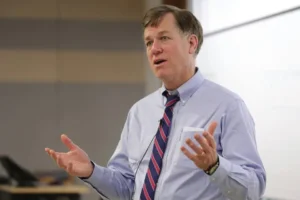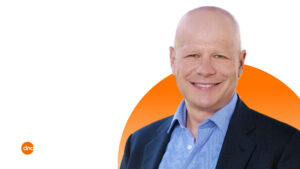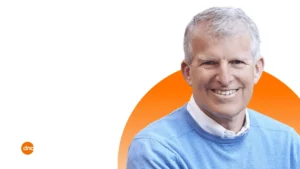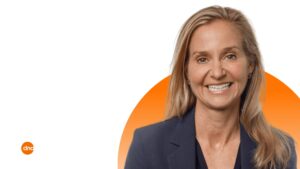How to Build More Credibility Using Customer Conversations
Maybe you’ve conducted or completed a customer survey or led a focus group. But, have you ever gone off script to uncover the real motivations and underlying needs that truly drive your customers?
Come dive deeper with us in this episode as Ashley Welch, experienced design thinker and co-founder of Somersault Innovation, shares why turning up the volume on curious listening can lead to breakthrough results. She breaks down exactly why design thinking leads to more sales success, and provides practical ways anyone can begin to build the power of co-creation into their daily work life. Learn how to keep the customer in focus and why there’s magic in understanding the motivations of others. Get ready to unleash your inner innovation and embrace the power of design thinking today!
Episode Guest

Ashley Welch is the endlessly curious co-founder of Somersault Innovation, a highly specialized consultative company that’s the first of its kind to apply design thinking to sales.
She works with high performing teams from companies like Microsoft, Oracle and Salesforce to build deeper connections with customers and increased revenue. She is the co-author of Naked Sales, a book about stripping away all preconceived notions and checklists when showing up in a sales situation and engaging customers in a more curious, empathetic and authentic way.
Ashley is the founder and co-leader of TEDxYouth@Wayland and she lives outside of Boston with her husband, two daughters, two Mexican street dogs, and three cats.
Follow Ashley and her customer centric insights on LinkedIn.
Podcast Host

Stuart Paap is laser focused on helping more people unlock brilliant and bold ideas. He works with pioneering biotechs and healthcare companies, and regularly presents at universities and tech incubators like the Harvard Innovation Lab. He’s also a former stand-up comedian and is a yellow belt in Judo, which strikes fear into no one.
Podcast Timeline
- 01:55 - Harnessing the Power of Design Thinking
- 04:55 - Customer Centricity: Your Competitive Edge
- 07:08 - How to Break Down Boundaries and Co-Create
- 08:13 - Mining the Underlying Motivations in Others
- 16:20 - Go Beyond Surveys to Customer Conversations
- 21:22 - Doing Better Discovery
- 23:58 - Ask Better Questions that Lead to Answers Full of Gold
- 34:04 - Finding the Hidden Magic in Customer Insights

Podcast Transcription
Stuart Paap:
00:00
Welcome to Stand Up To Stand Out The Podcast. I’m your host, Stuart Paap and for the last decade plus, I’ve been working with innovators and leaders inspire others to take action. My goal with this podcast is to give you practical, tactical advice that you can use now, whether you’re scaling a company, leading a new team, or advocating for meaningful change, this show is designed to help you make a positive impact with those who count. So let’s learn together and have some fun along the way. Let’s get to it.
I love Ashley Welch. She is the co-founder of Somersault Innovation. They do design thinking for sales teams, but for many different high performing teams. We have worked together. And she is also the co-author of a fantastic book that I recommend everybody check out, which is called Naked Sales. It’s a great read, very useful resource. My first question to you, Ashley, what is Naked Sales?
Ashley Welch:
01:07
Stuart Paap:
01:08
Hello.
Ashley Welch:
01:09
We, of course, chose the title because it was provocative, but what it really is all about is really showing up with curiosity and vulnerability in a sales situation and stripping away, getting rid of all the preconceived notions, your checklists and all the things you think you’re supposed to come armed with when you engage a customer. And really to strip back to your best curious, empathic self and show up in an authentic way.
Stuart Paap:
01:36
Harnessing the Power of Design Thinking
Ashley Welch:
01:55
Yeah, so design thinking I think of as just a recipe for innovation. It’s like a process or it is a process. Think of Agile six Sigma, lean, all of these are different processes. Design thinking is another one, tends to have five stages and a bunch of tools that go along the way in order to help a group innovate or solve a problem.
So it’s problem solving process. And what’s different about design thinking is it’s like ruthlessly focused on the end user or the customer. So it’s a customer-centric process, which means instead of you and I coming up with our best ideas for how to solve a solution, we would first look at who we were trying to solve for and really go deep in terms of understanding them and using what we learn about them to help us address the problem.
And so words like customer centricity, curiosity, empathy, fail fast prototype, co-creation, all of these sort of terms came out of the design thinking world. So people may not have heard of design thinking, but you’ve probably heard of all those words and you know more about design thinking than you think.
Stuart Paap:
03:00
Can you talk about those five steps and then I want to talk about why design thinking is important today?
Ashley Welch:
03:07
Yeah, so the first step is, if I was to make it really simple, is really empathizing with your end user, like I said. So let’s just use a very simple example. Let’s say I was going to make a glass because I think I have a better cup idea. The first thing I would do is investigate and really understand my end user, you, who would be drinking and all the other people who drink and really get to know them.
So that’s sort of the empathy step. And then I’m deriving insights from what I’ve learned that, oh, wait a second, I noticed that 60% of the people or 75% of the people that I observe are drinking between these hours and what does that mean? So it’s something interesting that I learn about them that helps me reframe the problem or opportunity.
And then I’m coming up with a solution to test basically, I’m prototyping something very small to test and get feedback with you. So my new cup that I might have come up with, I’m going to test and say, “Hey Stuart, I have this small prototype. I know it’s just a piece of clay, but how would you engage with that? Can you give me some feedback on that?”
And then I iterate from there and keep working towards creating the final solution. So I’m not coming forth with one thing, one and done. I’m coming forth with small incremental changes to the idea until I get it right. And the reason you use design thinking is you’re more likely to delight your end customer and you decrease risk of failure.
Stuart Paap:
04:30
What does someone do if they want to use these processes but they may not have the ability to innovate a product or they have a product that’s already been built or designed or it’s a multimillion or billion dollar product. What can design thinking do to turbocharge the relationships with the end user?
Customer Centricity: Your Competitive Edge
Ashley Welch:
04:55
Yeah, such a good question. Well, I think of design thinking more than anything is a mindset of customer centricity. Two things, customer centricity and co-creation. And I think just that idea of how do I stay really focused on who my end customer is and what they care about as I go forth in my process, whatever it may be, and how do I actually engage them to co-create or work with me in creating the end solution goes a long way.
So whether you’re in HR and you’re working with employees around comp or time off, whatever it is, you can work with your end user and think differently about how you’re engaging them. Whether you’re creating a product or you’re in sales and you’re working with a customer, being customer-centric and thinking about ways to co-create with that end user, that’s design thinking in and of itself.
For me, co-creation is involving the other entity, whether it’s an individual team organization in actually creating the solution or solving the problem with you versus one way. I’m going to solve it and give it to you. You think about your children who don’t want to eat something at night. If I just push the plate forward and say, “eat this,” I am not sort of co-creating the end game here and they’re much more likely to resist versus I say, “Hey dinner night, we have five different items. Why don’t you come forth and make your plate or make your taco or make your salad, you put on it what you’d like.” They’re much more willing to engage and eat that food. So that would be co-creation in a very simple way.
Stuart Paap:
06:34
So if I just get this right, the design thinking process is really putting the customer at the center of the conversation. You mentioned curiosity and I want to talk about that. We’ve talked about co-creation, which is really involving them in the decisions and helping build something or getting their opinion, getting their thoughts, and reflecting that back in a meaningful way. Can you still co-create with someone if your hands are sort of bound by the rules or the strict guidelines under which you have to conduct business?
How to Break Down Boundaries and Co-Create
Ashley Welch:
07:08
I even think about how do I co-create with him, which would mean call him regularly and say, “Hey, what do you need from me? Is there anything actually that you would suggest for me that I do differently in this process? What’s your advice to me? Like getting him involved in how we’re navigating this for me is co co-creation at the smallest level. So I think for all of us just asking the question, how could I be co-creating or involving the other group individual in this process, that thought experiment I think is helpful and you will come up with something.
Stuart Paap:
8:08
Talk to me about how listening factors into co-creation.
Mining the Underlying Motivations in Others
Ashley Welch:
8:13
Well, of course, it’s like the foundation of understanding what would be meaningful to the other person. So if we go back to my glass example, the way I become most innovative in what I might create for you, my end user, is really listening to you to understand not only what you might tell me, but trying to decipher underlying needs or motivations.
And in order to really understand that I have to listen really well and I think there’s this term active listening, which isn’t just hearing but then engaging with you saying, tell me more. It’s that curiosity piece of the listening that I’m withdrawing or drawing out of you more information and even things that you might not have thought about so that we both get smarter in the process. And I think you need all of that fodder in order to co-create well, because otherwise I don’t really know what you care about.
Stuart Paap:
9:08
So if someone’s new or they’re want to start with co-creation and they don’t even know where to begin, what would be an actionable step that they could start practicing right away to start to build that muscle?
Ashley Welch:
9:24
One thing I would think about as an action is how do I push myself to involve the other side actually sooner than I would’ve thought. So I think what you said in the beginning, we work with sellers most often, and so sellers are always thinking about how do I engage my prospect or my customer in a way such that they will buy?
And I think the bias is like I have to have it all together before I engage them or I have to know everything about their business before I will engage them. And we’re always pushing the people we work with to say, no involve even earlier. You might not know the answer completely or whatever you’re going to propose completely, but by involving them and even saying, I don’t have this all put together, but I’d love your input on this piece, they start to feel involved and connected and their fingerprints are starting to be put on it. So I would say think about what is a way to actually involve the other entity sooner than you might even be comfortable with.
Stuart Paap:
10:27
Do you have an example of co-creation in process?
Ashley Welch:
10:32
He had all the dealerships in addition to the manufacturer, the largest dealer was in Texas. And so he started what was a co-creative process, which is he spoke to the CIO, he knew that there was a digital transformation on the horizon. He said to her, “Hey, will you engage with me in this co-creative process and this is what the process is going to look like. I need 30 minutes with each of your executives. Then I’m going to go out into the field and I’m going to talk to a lot of people, and then I’m going to come back to you and your executives and I’m going to tell you what I’ve learned and you’re going to offer me your insights and anything else you think I need to learn, I’m going to go back out again, get more information and then come back to you again.
I have to think about always staying curious, customer-centric, and co-create right from the get go, just like you were talking about.
And then we’re going to start to talk about the solution and I want you to start to give me a sense of what you think about it. And then I’m going to go back, take that feedback, I’m going to iterate and I’m going to come back to you again.” And he got the CIO to say, “Okay, three hours of my executive’s time to think about the next 10 years of digital transformation. That’s worth it for me. Go ahead, do this.” So he got her to say yes, which his colleague said to him, “As soon as they say yes to this process, the deal is done.” You don’t know how big the deal is, but it’s done because they’re invested with you. So that’s sort of the big notion of co-creation in terms of engaging your customer right from the beginning. And then the story I was thinking about is he went down talking to the dealers in the south, he’s sitting next to one of them talking about servicing equipment.
And the guy says, “Well, I just got this intake, I need to set up the service on this piece of equipment.” And Matt said, “Well, I have this, it’s in my schedule, it says, call Scott. So I got to call Scott.” And Matt said, “What do you mean, call Scott is your system for maintaining equipment?” He’s like, “Yeah, I just got to call the guy who has the piece of equipment.” And he said, “Well, why don’t you just go to where it is?” He’s like, “Because I don’t know where it is. This is not GPS enabled. I got to call Scott for Scott to tell me.” So Matt took a picture of this thing that said call Scott on his computer and took it into the executives when he came back and said basically, this is an image of your service system. It’s Call Scott.
And so of course they were embarrassed, but in a way that said like, geez, let’s talk about how we can transform this with an digitally enabled system to help us be more effective. So Matt would say the only reason he got to that sort of end user story was getting in keep asking why, saying what does this mean? Call Scott and what if Scott’s not there? And all these things that were revealed by getting super curious and then bringing that back in a respectful way to the executives he was working with to say, “Hey, let’s talk about this situation. How can we help you be more effective in maintaining equipment and satisfying your customers?”
Stuart Paap:
14:14
It’s a wonderful story. And three things jump out at me. Number one, how prescriptive he was being telling everyone this is how we’re going to make it better.
Ashley Welch:
14:24
Yes.
Stuart Paap:
14:25
The second thing was just really sitting in that curiosity and asking more why’s and understanding. And then the third was actually presenting the problem in a way that was obvious now to them about the need for change. And I heard this yesterday that no one wants to be changed, but everyone is willing to change. They just don’t want to be changed. And I think about that with influence that you know, you don’t convince anyone of anything they convince themselves.
It seems like your process is perfectly set up to have people look at the data, look at their behaviors, look at the what’s happening and arrive at the conclusions and therefore they’re more powerfully connected to the solution.
Ashley Welch:
15:10
Exactly. And that’s the whole thing. And the one thing I always think about is this idea the end user’s stories are gold. I don’t care if you’re selling or doing anything else. If you can get up close to your end user in this case, I don’t know the gentleman’s name, the service person, and sit with them or talk to them and get a story about them that you then bring back. You just said people are like, “Well, I can’t argue with that and now it’s sort of in my face and let’s talk about that.” I’m much more likely to engage with you than if you just either use a use case or just tell me something that’s not relevant to me.
Stuart Paap:
15:47
It seems like one of the things that underpins this process, Ashley, is that essence of curiosity. And it reminds me of a quick anecdote that when Sony was rolling out the Walkman in the 1980s, they asked a group of kids, “Which color do you prefer, this yellow or black?” And they all said, oh, yellow. And then at the end they said, “Now you’re welcome to take a free one as a thank you for participating.” And they all chose black, so they were like, “Oh, there’s a disconnect between what they’re saying and what they’re doing.”
Go Beyond Surveys to Customer Conversations
Ashley Welch:
16:20
Stuart Paap:
17:04
Yeah.
Ashley Welch:
17:04
That’s another piece of gold because then you’re like, oh my god, you don’t know that… did I just discover something that actually applies to a lot of people that I can leverage?
Stuart Paap:
17:12
Why is this such a driving force for you, this curiosity and co-creation?
Ashley Welch:
17:18
I think because I was naturally born curious, fortunately. And so it’s part of my DNA and it comes naturally and easily to me. And therefore what I’ve seen over my life is that it really is the root of how I create deep relationships or how I have even created my company. And therefore a lot of goodness comes out of that curiosity and also my own understanding and learning. I’m so clear that I don’t learn enough about another person or a subject without going deeper and deeper. And every time I do, I’m like, geez, I never would’ve known all that.
Or I think totally differently about this now. I mean these are all such obvious things, but it just gets revealed to me every day. So it feels like it’s had a very positive impact on me and my life. And also you said yesterday to me, this idea of curiosity, sort of transforming ourselves, just the nature of curiosity, transforming how we feel and show up in the world, and I think that’s right. It just, there’s some positive energy that comes with curiosity.
Stuart Paap:
18:25
I agree. I got this advice was replace negative thoughts with curiosity and just see what happens. And even a hack being, if you narrow your eyes, you’re focused, which is good for solving problems, but opening your eyes can be a cue to remind you to stay aware of collecting more information and being more open. So I’m actually more even aware of just behaviors, but I can’t help but think about it. How can you encourage someone who’s got a different mindset? Maybe they’re more focused on data or problem solving or building things and they may not have that curious mindset. What would you say to them or how would you encourage them to start building those skills?
Ashley Welch:
19:06
I think with anything, for any of us, I’d say just try it. Try the idea design, try a little teeny thing and see what happens and what feedback you get. And so I would say try it at home, try it with your child, try it with your partner, try it with someone. People always after working with us will be like, “I just tried this at the Starbucks,” someone was giving me my drink and I just asked a question and then I asked another and what happened in terms of the transformation of that relationship?
So I think trying something small and asking one more question or two more questions and seeing what happens is the first place to start because this sounds ridiculous as we talk about it’s so simple, but it really is transformative in terms of the knowledge you learn and the relationships you build. And so if you can get a taste of that, I think that creates momentum for trying it more.
Stuart Paap:
20:01
And would you encourage people to try it in low stake situations just to start getting some confidence around this?
Ashley Welch:
20:08
I don’t know. The older I get, I think the high stake is good too. If I was on stage, the high stake situation would be like, let’s say I was on stage and I in front of 1,500 people and I was asked a question I didn’t know the answer to. Feels like lower stakes would be like to say something that was not really that interesting or to fudge some kind of answer. But higher stakes would be to say, I don’t know what you mean by that. Can you tell me more about what’s behind that question or how it would be helpful to me if you answered that question from your point of view first and then I’ll think about mine. As long as you’re genuine, I think either one works.
Stuart Paap:
20:46
Yeah, well, I’m not genuine, but I’m working on it.
Ashley Welch:
20:49
Yes, you are.
Stuart Paap:
20:57
I love what you’ve said to me in prior conversations, which is, and I’m paraphrasing, but if I could encourage people to stay curious just a bit longer, you reveal deeper conversations, hidden behaviors, motivations, and then therefore that leads to not only richer relationships but also richer and better deals.
Ashley Welch:
21:20
Yeah.
Stuart Paap:
21:20
Is that an accurate summary?
Doing Better Discovery
Ashley Welch:
21:22
Yes. I was just talking to someone yesterday at a tech firm who is a manager and we were talking about this notion of discovery, doing better discovery, and in order to do better discovery on your prospect or customer, obviously you got to stay curious and learn things. And she said, I said, “Tell me about discovery there. What does it look like? Who are your reps who are doing really well, who’s not doing well?”
And so she started talking about some of her reps who weren’t doing it well, and she says they have basically a checklist and they’re just going through their checklist of the thing that they need to ask and they don’t ask a follow-up question and they just do things happen. They sound weird. She said, “Don’t forget there’s a person on the other side of this conversation. “Don’t be weird if you’re asking a question, then ask your follow-up question as it relates to what you just asked.
And secondly, you miss all sorts of things. If I am just my checklist of questions because I got to sort of vet whether you are a viable customer or not, I just go down my checklist and I don’t reveal actually that there might be something more I wasn’t thinking about or much bigger opportunity than I was starting to narrow in on. So staying curious more often translates into all sorts of goodness, including bigger deals.
Stuart Paap:
22:36
How does someone prove to a skeptical manager that being curious longer and being, having richer conversations and understanding someone and putting the customer at the center, whoever your customer would be, that this will lead to just better outcomes across all categories.
Ashley Welch:
22:54
Well, you could read our book Naked Sales. There’s lots of examples of people being curious and it’s not just being curious and not intelligent about what you learn and follow up on. It’s like being smartly curious and how that’s translated literally into millions and millions of dollars. The story I just told you about, about the Matt of the tech firm, that became a three, no, sorry, a 14 million count. I’d want to say if someone ever said to me, prove to me that being curious is going to reveal more opportunities, I would say, tell me more about your skepticism around curiosity. It doesn’t make any sense to me. It’s just logic.
Stuart Paap:
23:32
So somebody wants to get started with curiosity or build those skills with their team. Is there a better approach to it with open-ended questions or what types of questions are going to start them on the right path? We don’t want it to feel like a checklist, but a checklist is sort of a push in the right direction as long as you’re not too prescriptive. So what types of questions are useful, Ashley?
Ask Better Questions that Lead to Answers Full of Gold
Ashley Welch:
23:58
Well, I think certainly open-ended questions, which means you’re not asking for a yes or a no, you’re asking for a descriptive response. I always think of this idea, you and I talk about this idea of just saying tell me more, or pointing something out and saying, tell me something about that or what you said about the earrings of I like them. And then, oh, where did you get them? That’s called a follow on question. You’re starting to dig deeper.
So I think just playing with that idea of just asking for more information about whatever topic is an easy entry. You don’t have to ask something specific. You can just say, well, can you expand on that more? Why is that meaningful to you or these general open-end questions. I also think just playing with it in what feels like whatever a safe space for you is, whether it’s at the cafe or whether it’s with your child or significant other before you bring into the business environment is a good thing to do.
And then the other thing I was thinking is there is a piece of this if you’re going to be genuinely curious is you do have to let go of the fact that you may not know where this conversation’s going and you have to let go of that sort of control because if you’re genuinely curious, then you’re going to follow the person. And of course, like you said, you’re, you have your other bumper car questions that are going to, or bumper, the bumpers on the side that are going to pull you back in the direction that you know want to go at some point. But relaxing into the fact that you don’t know where it’s going to go is also very helpful and then trying it out.
Stuart Paap:
25:33
Got it. So really just surrendering that you have to have the whole agenda. It’s sort of running a good party. You do all the planning and prep, but then once it’s go time, you have to be in the moment and be ready to respond.
Ashley Welch:
25:49
That’s a great example because if everybody was having fun at your party and you were like, “Okay, it’s 10:00 now we’re doing this, everybody move, now we’re doing this.” You’d be like, “stop telling me, guiding me. We’re already in the midst of a flow.”
Stuart Paap:
26:01
What I’m getting is there’s this push-pull between structuring it and having a general direction to understand someone, but also not holding onto tightly so that you’re not constrained because otherwise you feel like they’re running a script on you and it feels awkward.
Ashley Welch:
26:20
And it feels weird. I have another friend who teaches in the sales enablement space and one tactic he will use is if he does need to find some questions out that he’ll say, “If you don’t mind, I’d love to ask just some general questions that I’d love to get past with you and I’m just going to hit them really fast, and then I’d like to have a deeper conversation about X, Y, Z.”
And so then you’re sort of getting permission from the person you’re talking to, to ask some sort of what you might call qualifying questions and get those out of the way so that then you can go deeper with them. And if again it’s that’s a little bit co-creation, get me engaged in saying yes. Yeah, okay, I’ll participate in that then I’m all yours.
Stuart Paap:
27:09
I’ve learned so much from you over the years I’ve known you, but I think it’s staying curious to reveal magic that wasn’t on the menu.
Ashley Welch:
27:20
So I think there's always something more to be revealed that is surprising and delightful and perhaps magical.
Totally. Absolutely. Well, I just think you never know what’s going to show up, and I don’t mean to be like, oh so rosy, but everything’s just unicorns. But I do think that there’s like there’s the unknown that’s always sitting out there and for us to discover what that is together in a conversation, big or small, that I do believe that there is something waiting to be revealed if you just even think about it, a basic level of six degrees of separation, like this idea of if you and I spent long enough time or actually even more interesting, just some person I sat next to in the airport, we’d find out that we know someone in common or there’s some connection that we had no idea because we look like two random people sitting next to each other. So I think there’s always something more to be revealed that is surprising and delightful and perhaps magical.
Stuart Paap:
28:11
I love that. There’s something hidden in that magic. So what advice would you have for someone who’s like a tech entrepreneur building a new product that can change the world, or somebody who’s now a manager and they’re going to be running a team of high performing people across cultures, across time zones, across all kinds of things. What specific advice would you have for them to enrich their customer centricity? Because everyone has a customer, whether it’s an internal customer, an external customer. What would be some actionable things that they could do to just get started on this journey?
Ashley Welch:
28:47
I think that for example, this idea of prototyping or experimenting, let’s experiment I like is a better word. So for you to think if you’re a manager, leader, individual, whatever, how can I experiment with this idea, this innovation, this solution I’m going to think about in order to solve some problem, whatever it is, what’s the smallest thing I can do to experiment with this before putting it out in the world in its full form so that I can get feedback?
In teaching design thinking, that seems to be actually a hard thing for people to figure out because they over-engineer that experiment versus an experiment could be, I’m just going to write a couple things that I’m thinking about in terms of the solution on a piece of paper, I’m going to give it to you and get your feedback. I’m going to, if it’s a new iPhone, I’m just going to create a cardboard cutout of some of the things and some of the features I’m thinking about for this iPhone, I’m going to give it to you and get your feedback. So I do think this idea of figuring out what is the lowest fidelity way or experimentation with what you want to put out in the world that you can create in order to get a piece of feedback is one thing that I would suggest people start to think about.
Stuart Paap:
30:01
Well, I think there’s a real value. I have these post-it notes all over, but post-it notes, it’s funny, everyone has them. They’re ubiquitous. One of the things that’s the best about them is the weak glue on the back because there’s a beauty in presenting someone something that is half formed. And this goes back to co-creation where I’m saying, “Ashley, I have some ideas that I think would enrich our team. Here they are.” If you see them in a medium that doesn’t feel overly cooked …
Ashley Welch:
30:32
Exactly.
Stuart Paap:
30:34
… you are going to participate with me. All right, so two more questions. So is there anything I didn’t ask you about that would’ve been useful to touch on or something that is of interest to you that you would want to share?
Ashley Welch:
30:48
Well, I’ll say one of the things that seems to be most useful and interesting to the sales teams that we work with, and I think this is applicable in all different places, is this notion of understanding two things about your end user. Let’s say your end user is an entity, you’re working for a corporation, this idea of what are their big bets, their big macro priorities, understanding that and then understanding, okay, who are the end users that they care about and we might care about, they might be internal people and I’ll give you a real example, or they might be external customers.
And then figuring out how you can connect the dots and see the relationship between those two. So for example, talking to a security firm yesterday, like a tech security cybersecurity, and they were talking about the fact that Gallagher, which is an insurance firm, was one of their customers.
So the rep was smart enough to realize that if he just talked sort of cybersecurity, he would only be talking at one level, but if he started to talk about their big bets, and one of the big bets is they grow through acquisition and they had had a threat a couple years ago and the shareholders had said, we’re not going to basically allow you to continue acquiring companies because there’s a security risk.
So his conversation then went at this macro priority level, which is I know you Gallagher care about growth, your growth through comes through safe acquisition or acquisition and your reduction in security risk is related to your ability to acquire. So he oriented to the conversation towards that big bet, which is for anyone, what we want to do is right, thinking about the aspiration of the individual or the company and relating what we’re talking about to it.
...getting really close to them enough so he could talk about the relationship between what they cared about and his services such that he could connect the dots there. hat's very powerful for any of us...
And then the end user piece is understanding who were the end users in this case internal to Gallagher, who would be using this software and what did they care about, the security analyst, the tech team, the technical leader, and getting really close to them enough so he could talk about the relationship between what they cared about and his services such that he could connect the dots there. That’s very powerful for any of us to be able to talk at both levels once we have an understanding of the big bet and then the end users and what they care about.
Stuart Paap:
33:10
So if I’m understanding you correctly, it’s understanding where they want to go, but also who has to use the tools to get there.
Ashley Welch:
33:18
Stuart Paap:
33:34
Wow. Well, we just found some magic in here that is just wonderful to hear.
Ashley Welch:
33:40
Take that out for a spin.
Stuart Paap:
33:47
I love it. So my last question to you, Ashley, if you were to give one piece of advice or inspiration to people who are listening to this, whether they’re wrestling with co-creation or curiosity or thinking about big bets and end users, what would you say to them?
Finding the Hidden Magic in Customer Insights
Ashley Welch:
34:04
We were talking about magic a little bit. I always think there is magic in these end user stories and the magic comes from if I can get close to my end user, whoever that might be or my customer and get real stories about them, that transforms me. All of a sudden I care differently about them and the corporation and it transforms my conversations with other people because I can reference that story that’s real and it creates credibility for me. I’ll just end with one story.
This is actually about Matt as well. He was a young seller at the time. He was working with Ashley’s Furniture, nothing to do with me, and we had to said go in, have an experience as a buyer there as a customer. So he did. He got all sorts of information about colors and what did and did not work when you were picking out furniture.
He then got a meeting with a leader there and the first thing out of the leader’s mouth was, “You look like the age of my son,” which obviously is a downer when you hear that. And so sort of Matt took it in stride and then he said, “I’d love to share with you a couple things that I experienced when I was in your store.”
Stuart Paap:
35:38
One of the things I got from that story, and thank you for sharing that, is that you can really build credibility through putting yourself in that empathetic point of view of experiencing the product or service through a critical eye in a way of gathering insights and making observations.
Ashley Welch:
35:59
Yes, for sure. That’s why I was saying like there’s magic in this because it gives you all sorts of things, including credibility when you have those end user insights and understanding of motivations or just what’s happening on the ground.
Stuart Paap:
36:13
There’s a book that came out called Messengers, and they basically say that to be a good communicator, helping teams communicate effectively, you have to have two things. You have to have warmth and credibility. And so warmth is of course showing that you care, but credibility, you can build your own data set by collecting insights from your own experience.
Ashley Welch:
36:35
Absolutely, and in this case that I just mentioned, everybody likes to hear about themselves.
Stuart Paap:
36:42
Well, Ashley, this was a beautiful and inspiring and fun conversation as always with you, and it was just a pleasure to speak with you. So what is the best place for all the listeners to go to find out more about you and what you do?
Ashley Welch:
36:56
Yeah, I’d say our website, somersaultinnovation.com and Somersault, check your spelling is S-O-M-E-R-S-A-U-L-T, Innovation with no S or LinkedIn. I’m on LinkedIn all the time. Ashley Welch at Somersault Innovation.
Stuart Paap:
37:14
Ashley, thank you so much for being on Standup To Stand Out. I look forward to seeing you soon and I can’t wait to reconnect very shortly. So thank you.
Thanks for listening to the Standup To Standout The Podcast. If you’re enjoying the show, I urge you to check out influenceDNA.co and find the podcast page where you can find show notes, links to the guest, extra resources and whole lot more. Also, you can subscribe on YouTube, Spotify, Apple Podcasts, and make sure to sign up for our mailing list.
If you have questions about the show or comments about how we can improve it, drop us a line. I will read every single message that’s [email protected]. If you like what you heard, I’d say leave us a five star review and if you hated what you heard, leave us a six star review. Either way, we’re not stopping. See you on the next show.
Inside the Influence Lab
Episodes
Articles

Building a Strong Speak Up Culture for Business Success




Closing the Leadership Intent-Impact Gap




















